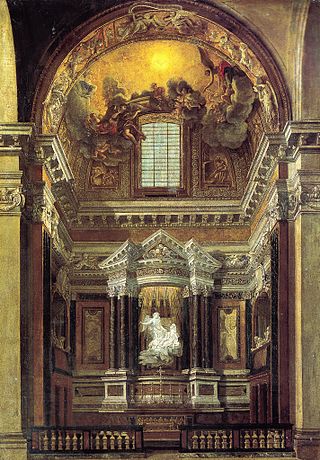Related Research Articles

Benedetto Briosco (c.1460–c.1517) was an Italian Renaissance sculptor and architect, active in Lombardy.
Jacopo Bambini was an Italian painter of the Baroque period, active mainly in Ferrara.

Simone Barabino was an Italian painter of the late-Mannerist style. Born in Val de Polcevera, near Genoa, he was mainly active in his native city, where he trained with Bernardo Castello. He later feuded with his master and left for Milan, where after some works, he stopped painting. Notable works include San Diego restoring sight to blind child for the Nunziata del Guastato in Genoa and Dead Christ with the Virgin and Saints Michael and Andrew for the church of San Girolamo at Milan. He died in penury. Lanzi says he quit his profession and turned to merchandise, in which he did not succeed, and that be died in prison. The exact date of his death is not known, but he may have been quite old when he died.
Giovanni Antonio Amato or Amati was an Italian painter of the Renaissance period. Born in Naples, he copied the style of Pietro Perugino.

Ippolito Andreasi was an Italian painter of the Renaissance period. He was a pupil of Giulio Romano in his hometown of Mantua. He collaborated with Teodoro Ghisi in painting the ceiling and cupola of the Cathedral.
Giuseppe Appiani was an Italian painter of the Neoclassic periods. He was born in Vaprio d'Adda, near Milan, where he was mainly active. His parents moved to Monza, where his first mentor was the painter Giovanni Maria Gariboldi. At age 21, he moved to Milan, where he worked in the studios of Giorgi, and later Giuliano Traballesi. He was active in restoration of paintings. Another painter, Giuseppe Appiani, was active in Germany.

Domenico Auria was an Italian architect and sculptor of the Renaissance period, active in Naples. He was a pupil of Marliano da Nola. He is also known as Giovanni Domenico or Giovan Domenico Auria, or Domenico d'Auria.
Cesare Baglioni was an Italian painter of the Renaissance period. He trained under his father, then became renowned as a painter of quadratura. He painted in Parma and Rome. He befriended both Agostino and Annibale Carracci. Leonello Spada apprenticed with Baglioni.

Giovanni di Balduccio was an Italian sculptor of the Medieval period.

Pietro Balestra was an Italian sculptor of the late-Baroque period. He was born in Siena, and was best known for his work in marble in Dresden, including a Meleager slaying the Calydonian Boar; Venus and Cupid, and Boreas and the Rape of Orithyia.
Martino Bassi (1542–1591) was an Italian architect active in the Renaissance period, mainly in Milan. He was born in Seregno near Milan. He was involved in a public dispute regarding the baptistery of the Cathedral of Milan. He helped build the imposing facade of Santa Maria presso San Celso. He also built the church of Santa Maria al Paradiso.
Gaspare Bazzani was an Italian painter active in Reggio Emilia as a painter of vedute or landscapes, as well as a scenic designer.
Lorenzo Bergonzoni was an Italian painter of the Baroque period. He was born and active in Bologna. He was first a pupil of Giovanni Battista Bolognini, but afterwards studied under Guercino in Cento. He is also called Lorenzo Bergunzi. He became known mostly as a portrait painter at Bologna.

Giovanni Maria Bottala (1613–1644) was an Italian painter active in the Baroque period.

Giuseppe Bottani was an Italian painter active in the Baroque period.
Carlo Girolamo Bersotti was an Italian painter, active during the Baroque period in Milan. He was a pupil of Carlo Sacchi (1617-1703), and painted mainly landscapes, still lifes, and animals. Also called Borsotti.

Simone Brentana was an Italian painter of the Baroque period, active in Verona. He was born in Venice to Domenico Brentana, but became orphaned by age nine. After a prolonged desultory education in various fields including music, he trained as a painter in Venice with Pietro Negri, frequenting the Accademia di Belle Arti, moving in 1685 to Verona, where most of his paintings are located.

Guido Ubaldo Abbatini (1600–1656) was an Italian painter of the Baroque period, active mainly in Rome and Usigni.
Stefano Ticozzi (1762-1836) was an Italian art historian.
Cristoforo Ciocca (1462–1542) was an Italian painter of the late-Renaissance, active in Milan. Little biographical information is known, except that he was the pupil of Gian Paolo Lomazzo. He painted a San Cristoforo altarpiece for the church of San Vittore al Corpo, Milan. He mainly painted sacred subjects and portraits.
References
- Ticozzi, Stefano (1830). Dizionario degli architetti, scultori, pittori, intagliatori in rame ed in pietra, coniatori di medaglie, musaicisti, niellatori, intarsiatori d’ogni etá e d’ogni nazione' (Volume 1). Milan: Gaetano Schiepatti. p. 293.